

December 2, 2003 |
 |
|---|
A large portion of the wheat crop was planted in two time frames. The wheat that was planted early and received timely rain developed rapidly if adequate fertility was available. An insect battle was necessary on some acreage to maintain an adequate stand. Some producers had to apply insecticides and other acreage had high levels of natural enemies. Shown below are pictures of mummified aphids and parasitic wasp(s) emerging from the aphid shell. The November planted wheat is progressing well and may provide some grazing in the near future, if weather allows for plant development.
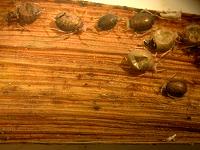 |
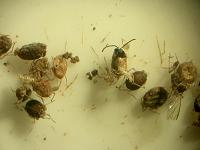 |
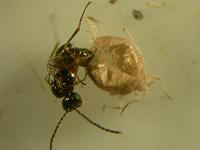 |
|---|
Broadleaf weed control has been needed on a large portion of the early planted wheat. The control of broadleaf weeds is important to save the moisture and nutrients for the developing small grain crop. On some unsprayed acreage, thistle has grown large enough that the maximum rate of herbicide may only burn and knurl the plants instead of killing it. If you have a weed problem now, read the label closely and select the appropriate herbicide for the weeds needing controlled.
There are several dead and injured leaves on the developing wheat and it is causing producers some concern. The leaf damage is generally due to insects (aphids) and disease (leaf rust). Most of the leaf tip burn was caused by freezing temperatures that impacted the lush tender growth.
An inadequate amount of needed nutrients is apparent in some small grain acreage. When the need for nitrogen is not met in the developing small grain plant growth is slower than expected and plant coloration is light green to yellow. An application of nitrogen should be beneficial, however, producers should give special consideration to the type of fertilizer applied. Half of the nitrogen in ammonium nitrate is available at the time of application. This results in a quick response to the fertilizer applied. Other types of fertilizer have to be converted to a form used by the plant and this conversion is slowed by the cool temperatures.
Producers that are planning on grazing wheat need to make sure the secondary root system has developed. The secondary root system serves as an anchor for the plant and keeps the cattle from pulling the plants out of the ground. If there is no secondary root system, then grazing should be postponed until a later date.
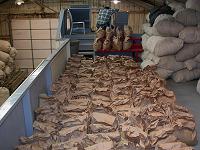 I want to thank Warren Multer, Robert Scott, Steve Sturtz and Tommy Yeater, for their assistance in ginning cotton on November 24 at Lubbock. We were able to process 350 samples in
I want to thank Warren Multer, Robert Scott, Steve Sturtz and Tommy Yeater, for their assistance in ginning cotton on November 24 at Lubbock. We were able to process 350 samples in 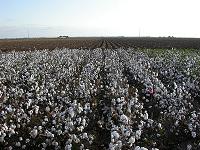 seven hours due to the effort made by all counties. The gin sample sizes between 600 and 650 grams processed quickly with very few problems. Thanks again for taking the time to weigh and prepare your samples. I expect to receive the textile lab information in the near future. I will get these run through the spreadsheet and out to you as quickly as possible. I plan to send the results out as an e-mail attachment. That will allow you to insert the data tables into your result demonstration reports.
seven hours due to the effort made by all counties. The gin sample sizes between 600 and 650 grams processed quickly with very few problems. Thanks again for taking the time to weigh and prepare your samples. I expect to receive the textile lab information in the near future. I will get these run through the spreadsheet and out to you as quickly as possible. I plan to send the results out as an e-mail attachment. That will allow you to insert the data tables into your result demonstration reports.
It was a busy year for cotton harvest aid work and I appreciate all the assistance provided by co-workers and producers. A summary of the work for 2003 is linked here.
If it isn't there try this link -- Texas A&M University System Search Engine.
For those of you looking for information on weed identification and control, the http://twig.tamu.edu URL may be one you want to bookmark. This site is intended to be a one stop site for information concerning weed identification, weed control, herbicide injury, pesticide labels and MSDS sheets.
If your looking for a couple of work related Christmas Gifts for yourself you might want to add these two items to your reference library at the office. 1) Crop Protection Handbook 2004 by MeisterPro and 2) Plant Identification Terminology, An Illustrated Glossary by James G. Harris and Melinda Woolf Harris
On December 3, a five-hour CEU course will be held at the Methodist Hall in Menard. This training is being hosted by Texas Cooperative Extension and the Texas Department of Agriculture. The target audience is Ag Producers and Home Owners. For more details and to register for the meeting call Billy Kniffen at (325) 396-4787.
On December 8, there will be a training conducted at Abilene for producers needing to obtain a Private Applicators license. For more details and to register for the meeting call Gary Bomar at (325) 672-6048.
On December 10, a SPCB/TDA Conference will be held at the Abilene Civic Center. This training is being hosted by the City of Abilene, Texas Cooperative Extension, and the Texas Department of Agriculture. The target audience is Landscape/Turf. For more details and to register for the meeting call Gary Bomar at (325) 672-6048.
On December 11, a five-hour CEU course will be held at the Texas A&M Agricultural Research and Extension Center in San Angelo. This training is being hosted by Texas Department of Agriculture and Texas Cooperative Extension. The target audience is Right-of-Way certified applicators. For more details and to register for the meeting call Cain Cline at (210) 820-0288.
On December 12, a three-hour CEU course will be conducted by Texas Cooperative Extension Offices of Coleman, Concho and Runnels Counties in Coleman County. The target audience is owners of Rangeland. For more details and to register for the meeting call Lance Rasch at (325) 625-4519.
On December 16, a six-hour CEU course will be held at the Memorial Building in Eldorado. This training is being hosted by Texas Cooperative Extension. The target audience is TDA Certified Pesticide Applicators. For more details and to register for the meeting call Scott Edmonson at (325) 853-2132.
On December 17, a five-hour CEU course will be held at the Taylor County Extension Office. This training is being hosted by Texas Cooperative Extension and the Texas Department of Agriculture. The target audience is Ag Producers and Home Owners. For more details and to register for the meeting call Gary Bomar at (325) 672-6048.
 December 1, District Office, Office Conference
December 1, District Office, Office Conference
 December 1, Tom Green County, Friends of Extension Luncheon
December 1, Tom Green County, Friends of Extension Luncheon
 December 3, Menard County, CEU Course
December 3, Menard County, CEU Course
 December 5, District Office, TCFF Training
December 5, District Office, TCFF Training
 December 8, District Office, Goldmine Training
December 8, District Office, Goldmine Training
 December 9 & 10, Brown County, Professional Board Meeting
December 9 & 10, Brown County, Professional Board Meeting
 December 11, Tom Green County, CEU Course
December 11, Tom Green County, CEU Course
 December 12, Coleman County, Range Recovery Meeting
December 12, Coleman County, Range Recovery Meeting
 December 15, Lubbock County, Gin District 7 Cotton Samples
December 15, Lubbock County, Gin District 7 Cotton Samples
 December 16, Schleicher County, CEU Course
December 16, Schleicher County, CEU Course
 December 17, Taylor County, CEU Course
December 17, Taylor County, CEU Course
 December 18 & 19, Tom Green County, Weather Station Setup and Training
December 18 & 19, Tom Green County, Weather Station Setup and Training
 December 19, Tom Green County, Office Meeting
December 19, Tom Green County, Office Meeting
 December 22 - 31, Potter, Randall, & Deaf Smith Counties, Christmas Holidays
December 22 - 31, Potter, Randall, & Deaf Smith Counties, Christmas Holidays
 January 5, District 7 Office, Office Conference
January 5, District 7 Office, Office Conference
 January 6 - 10, San Antonio, Beltwide Cotton Conference
January 6 - 10, San Antonio, Beltwide Cotton Conference
 January 13, Howard County, Soil and Soil Fertility
January 13, Howard County, Soil and Soil Fertility
 January 16, Tom Green County, Professional Ag Workers
January 16, Tom Green County, Professional Ag Workers
 January 19, Dawson County, Lamesa Cotton Conference
January 19, Dawson County, Lamesa Cotton Conference
 January 20, Martin County, Multi-County Cotton Conference
January 20, Martin County, Multi-County Cotton Conference
 January 21, Midland/Ector Counties, Soil and Soil Fertility
January 21, Midland/Ector Counties, Soil and Soil Fertility
| Sincerely,
|